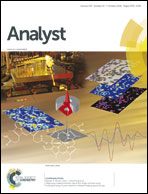Hydroxylated near-infrared BODIPY fluorophores as intracellular pH sensors
Abstract
In this study, a series of new, highly sensitive BF2-chelated tetraarylazadipyrromethane dyes are synthesized and analyzed to be suitable as on/off photo-induced electron transfer modulated fluorescent sensors for determination of intracellular pH. The ethanolic solutions of the new indicators feature absorption maxima in the range of 696–700 nm and a fluorescence emission maximum at 720 nm. Molar absorptivity and fluorescence quantum yield data were determined for the studied set of aza-BODIPY indicators. These indicators have high molar absorption coefficients of ∼80 000 M−1 cm−1 and quantum yields (up to 18%). Corresponding pKa values of indicators are determined from absorbance and fluorescence measurements and range from 9.1 to 10.8, depending on the selective positioning of electron-donating functionalities. The excellent photostability of the aza-BODIPY indicators makes them particularly suitable for long duration measurements. The in vitro cellular staining of living tissues in PC3 cells based on the isosbestic point at pH 7.8 and pH 9.3 has been employed which shows an increase in fluorescence intensity at 800 nm with increase in pH for certain compounds and fluorescence intensity decreases at 700 nm. Therefore, the new indicators are suitable for exploitation and adaptation in a diverse range of analytical applications.


 Please wait while we load your content...
Please wait while we load your content...